SHUMI Winery #207

"SHUMI" is the place that unites wine and art lovers
SHUMI WINERY and TOURIST COMPLEX is located in the famous region of Georgian winemaking, in the village of Tsinandali, Kakheti, Georgia. It occupies a historic location and borders the National Park and Museum named after A. Chavchavadze. This land belonged to the kings of Georgia and Kakheti, prince Alexander Chavchavadze, Georgia’s national poet, and served as a part of the summer residence of the Russian Emperor Alexander III.
Prince Alexander Chavchavadze was a Georgian public figure, the greatest Georgian romantic poet, lieutenant general of the Russian imperial Army, father-in-law of Alexander Griboyedov. His residence was the place of active cultural life of Georgia XIX, which was visited by famous people from all over the world, who in their memoirs said the following about Tsinandali: “Tsinandali is a magical place.” A.Dumas (Father); “Soon I will live as a hermit in Tsinandali.” (A.Griboyedov) and others.
Initiating wine tourism in Georgia
The territory, where SHUMI is located, as a result of the flood of 1865, turned into a rocky shore. The Company cleared and drained the marshland. After that, a unique Tourist Complex was built, which became a center of attraction for tourists from all over the world. SHUMI began its activity in 1997, acquiring historical terroirs in different microzones of Georgia, with a thousand-year tradition of viticulture-winemaking. SHUMI WINERY was built in 2001, and since 2002 the Company was the first in Georgia to offer tourist and gastronomic services to visitors.
Discover the unique and authentic Tourist Complex
The SHUMI Tourist Complex spans nine hectares, which has no analogues in the world both in its infrastructure and in content. Nowhere else will you find so many examples of Georgian culture gathered in one space as in SHUMI: the largest Private Vineyard with a Comprehensive Varietal Collection, the First Wine Museum in Georgia, the Decorative Garden, which presents sculptures by famous Georgian and international artists, the Marani, the Enoteca, the Georgian Ethnographic Pavilion, the VINOBIZA Pavilion, the Gestalt House, Gastronomic Zone with Restaurant, Cafe, Terraces, Tasting Areas and much more.
SHUMI Tourist Complex includes 39 locations, and works of art can be found here at every step. The statue “Gate Keeper” greets guests at the entrance. This is a bronze statue of a modern sculptor, created based on a painting by the great Georgian artist Niko Pirosmani. There is also a waiting area called “Spring of Beauty” and in the center of it is a stone fountain crowned with a bronze statue of birds, and around it is a small pond decorated with small lotus flowers. The work belongs to the contemporary Georgian artist Gela Duruzheli. Further along the way to the central part is the installation of Lazarus (Georgian ancient deity), where the ritual of Lazarus is held, and you can also see an ancient grape press carved in stone. On the left side of the road is the ZIGU Grotto. It is located underground and merges with the natural landscape. The Grotto is the cellar of the Zigu (alcoholic beverage) where it is aged for several years. There is a small café in front of him.
One of the oldest wine-making vines in the world grows in the private estate of N. Nikolaishvili in Tsinandali village. Experts from around the world have been studying this unique vine for some time. The scientists have managed to determine the approximate age of the vine – more than 300 years, but the exact grape varietal remains unknown. SHUMI WINERY together with the family of N. Nikolaishvili have named this vine GENESIS. In honor of this ancient vine, SHUMI installed a monument-sculpture of the GENESIS vine on the territory of the Tourist Complex. Its creator was the famous modern Georgian architect Giorgy Khizanishvili. Around the statue are planted the “babies” of the GENESIS vine. The GENESIS statue is a favorite place for wedding ceremonies. In 2016, conditions were favorable for the harvest of GENESIS grapes, and SHUMI’s masters produced dry red wine. The amount of wine was extremely limited, and each bottle of wine has a unique hand-painted GENESIS vine made by a professional artist.
In the Central part of the Complex there are tasting and dining areas with open and closed spaces built in small and medium-sized architectural forms, created by modern Georgian architects and designers according to projects designed exclusively for SHUMI. Only natural building materials are used in construction: stone, Georgian brick and tiles with blue enamel, wood, iron. And handmade elements created specifically for SHUMI are used in decoration. On the lawn in front of the tasting area there is a picturesque Water Mill with a barbeque zone. Many traditional Georgian dishes are cooked over an open fire, and barbecue meat and fish are prepared using a water mill and SHUMI‘s patented technology. Also in the dining area is the Gallery, where the works of famous Georgian artists and sculptures are exhibited, including masterpieces of famous modern masters, such as: Merab Merabishvili, Gia Japaridze and many others.
In SHUMI, everything is original and different from others
The Cellar, where wine is produced in Qvevri and aged in barrels, is built of Georgian brick, there is a fresco on the wall where the inscription is made using the ancient Georgian alphabet, and the barrels of Qvevri, buried in the ground, are guarded by the bas-relief “Devi” (Giant), the hero of Georgian fairy tales. On the wall there is an installation showing the fermentation of pulp in Qvevri.
The Complex also houses pavilions: VINOBIZA, ILLERCO and TSITELI DOLI. The walls of the pavilions are decorated with frescoes. These frescoes are painted with “Saperavi” wine and reflect the history and culture of Georgia, based on mythological characters and stories.
On the western wall of the VINOBIZA pavilion is the famous story of the visit of the first “official tourists” to Georgia – the expedition of the Argonauts about 33 centuries ago, whose main goal was to take the Golden Fleece. And, indeed, Georgia was considered one of the main centers of gold mining and the birth of metallurgy, as evidenced by the world’s oldest mine for the extraction of this precious metal, found on the territory of Georgia. The Greeks were known to look down on other people as wild tribes. Imagine their surprise when they arrived in Georgia and saw the prosperous cities. fountains of wine etc. Another fresco shows scenes from the life of Georgia at that time, including grape harvesting and grape pressing and winemaking. Georgia was a country of cultural farming, where, in addition to grapes, fruits and wheat were grown and honey was collected (the oldest honey ever found in history was found in Georgia, and it is 5,000 years old). Therefore, the ancient Greeks called the country Georgia – the country of farmers.
Much of Greek mythology consists of Georgian characters and Georgian history. On the frescoes you can see Minotaur. The fact is that the minotaur was Georgian. The mother of Minotaur was Pacifaya, wife of the Cretan king Minos, also sister of the Georgian king Aeitus and Medea’s aunt. Sisters of Minotaur were: Pacifaya’s daughters – Ariadna, Fedra, as well Kirka (Circe) – a sister of Pacifaya and an aunt of Medea as well, who saved Odysseus and married him.
In the center - an Ethnographic pavilion
Georgian brick, tiles and wood were used for construction. The pavilion contains ancient artifacts of winemaking and everyday life: a wooden grape pressor, a distillation apparatus for chacha, tools for cleaning Qvevri and making wine, various household utensils, etc. There is also a built-in “tone” – a clay “oven” for baking bread. There, guests of the Complex not only join household items, but also bake bread, press grapes, distill chacha and take part in culinary master classes.
Gestalt House, SAPERAVI Café and SHUMI Wine Museum
Next to the Ethnographic Pavilion is the Gestalt House (Therapy) a place to restore mental and physical harmony and get balance. The idea of creating the Gestalt House is based on the Company’s care for the mental health of the people. Human nature tends to strive for the integrity of the perception of the world and balance, and we help in this in the Gestalt House. For the construction of this House, only natural building materials were used: wood, tiles and stone.
In the center of Gestalt House there is an open fire, which, according to ancient traditions, was built in Georgian houses. Nearby is a stone sculpture of Amirani, a hero of Georgian mythology – the prototype of Prometheus (in Greek mythology), who stole heavenly fire from the gods, for which he was punished and chained to a rock in the cave of the Caucasus Range. According to legend, he was freed by Hercules, the hero of another Greek mythology, whose bronze statue depicting the scene of the last feat of Hercules (his strangulation with his bare hands of Cerberus, the three-headed dog guarding the entrance to Hades), can be found in the Gestalt House. There is also a “Sculpture of Mixed Roots”, where at the bottom of the sculpture there are soil samples of SHUMI’s vineyards, collected from different microzones: Mukuzani, Tsinandali, Napareuli, Kindzmarauli. In the middle there is a fountain from which chacha (Georgian traditional strong alcoholic beverage) is poured, and the upper part is crowned with a bronze statue of a vine.
There is also SAPERAVI Café, designed by the famous Georgian architect Archil Kalatozishvili. From its open veranda and tower offers a fantastic view of the Caucasus Mountains.
In the center of the Complex is a statue of the Griffin, made by one of the best animalists in the world Merab Merabishvili. The symbol of SHUMI is a Griffin (“Phaskunji” in Georgian mythology). According to an ancient legend it was the griffin who brought the first bunch of grapes to people, which gave a start to the cultivation of vineyards on Earth. Merab Merabishvili is a famous Georgian sculptor of many famous works that can be found in many countries of the world. He created many works for SHUMI, including: Griffin in stone, statues of bronze Griffin and Lion. He also created a gilded porcelain vessel, which has the shape of a griffin and is a handmade work of art and where SHUMI brandy is poured.
SHUMI uses exclusive glassware for its unique beverages: Lazare and Genesis wine bottles, painted by famous artists, among whom there is a painting by the world-famous contemporary Georgian artist Sergo Tbileli. The exhibition of Sergo Tbileli’s works was organized in 14 countries of the world.
In the garden of the Tourist Complex there is a fresco of Trialeti. The plot of the fresco is borrowed from the central frieze of the Trialeti Bowl, it is made of silver and belongs to the Trialeti culture – the archaeological culture of Transcaucasia, dating back to the Bronze Age (the first half of the 2 thousand BC) and is marked by a high level of local jewelry. The fresco depicts a ritual procession of priests with outstretched arms holding bowls facing the throne on which the supreme deity sits.
At the entrance to the building, where the SHUMI Wine Museum, Marani (wine cellar) and Enoteca are located, is the painting “Adam and Eve” – an artistic enamel work made in the technique of engraving with hot enamel on copper by the planar method, which requires high-quality fine craftsmanship and is very laborious. The Master’s work is unique both in technological terms and in terms of his non-standard approach to the depicted plot. The artifact depicts a classic biblical story, but in a free interpretation: instead of a Garden of Eden, the action takes place in a Vvineyard; where, in addition to Adam, Eve and the Snake, there are images of birds and animals that bear a symbolic load taken from the Bible itself; instead of an apple tree fruit, a bunch of grapes, and Eve is covered by a grape leaf. This work is unique.
The first wine museum in Georgia is a special pride of SHUMI. The exhibits are artifacts discovered during archaeological excavations in Kakheti. The Wine Museum’s oldest artifacts are more than 6,000 years old. Among them are a 3300-year-old clay vessel – Qvevri for winemaking. Although it is located in the ground, the outside is decorated with ornaments, which indicates the attitude of the owner to it. The museum houses a silver-plated wine cup dating back to the 7th century. It was found at the Nadarbazevi site belonging to SHUMI. Many centuries ago, the residence and vineyards of the Georgian royal family were located on this territory. The original cup was transferred to the National Museum of Georgia, and a copy is exhibited in the SHUMI Wine Museum. The cup is named “Ilerko”, “ilerko” meant a glass of precious metal in the ancient Georgian. SHUMI named the vineyard where the cup was found “Ilerco” and gave the same name to the wine made from grapes grown in this vineyard.
The museum also preserved copies of 2 art works: Statue of a bronze vine and a Patron Deity of wine from the 11th-10th BC and the silver “Bowl of Trialeti”, the originals are kept in the National Museum of Georgia.
The bronze figurine was discovered during archaeological excavations on the territory of an ancient pagan chapel in Kakheti. He holds a dagger in one hand and a weapon in the other. It seems that the Georgian character always meant to meet the enemy with hostility, and the beloved with wine. “This statue combines all the masculine features that were important for the tribal society and the patriarchal system of that time. He holds in his hand a mistress, an enemy with weapons, and at the same time he is a sower of grace,” wrote Georgian scholar Erekle Koridze.
SHUMI pays great attention to the landscape design of the complex. The territory of the SHUMI Tourist Complex is recognized as “the most beautiful place in Georgia”.
Various cultural events are often held in the complex. The company has its own folklore group SHUMI – an ensemble of vocalists, many dance groups, singers and musicians perform on the stage of the Complex.
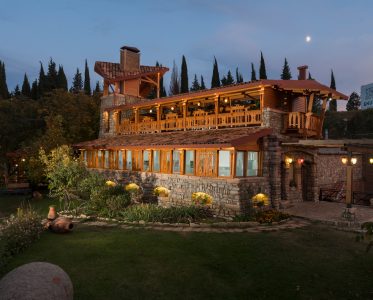
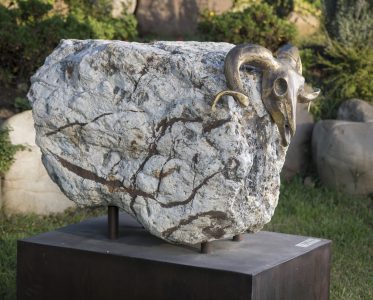
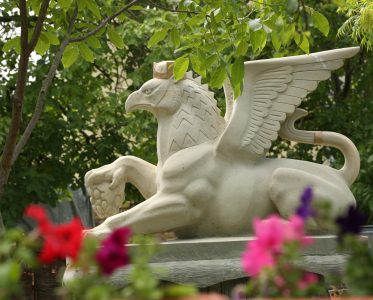
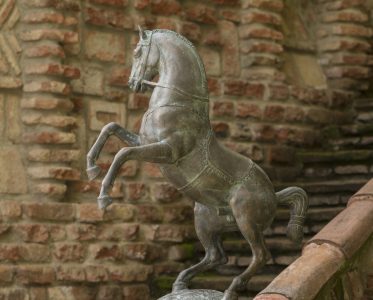
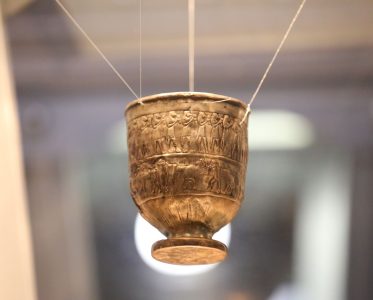
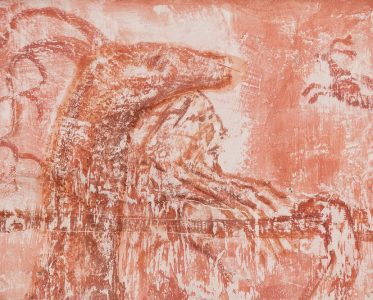
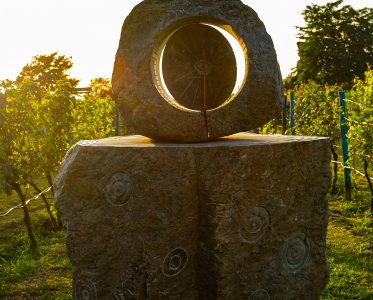
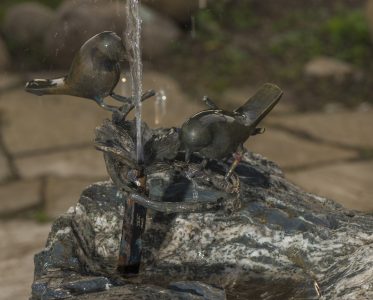

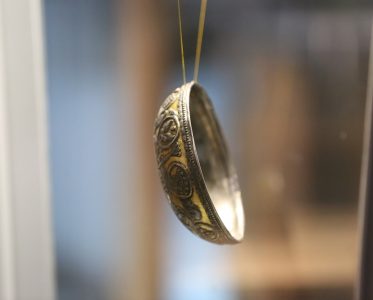
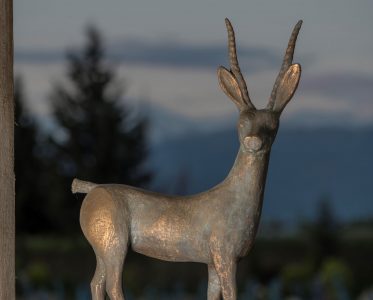
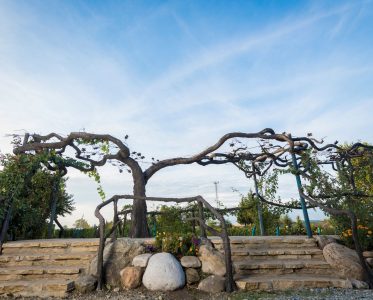
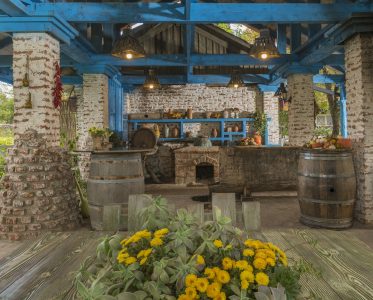
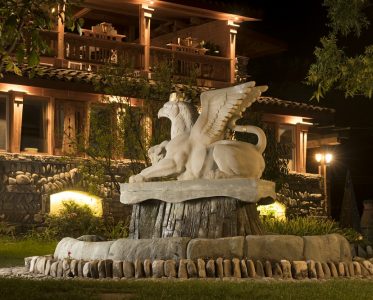
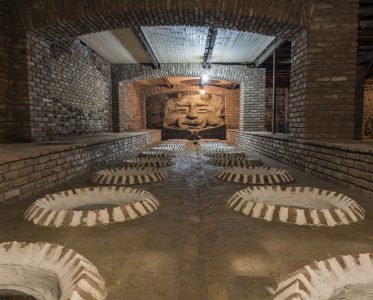
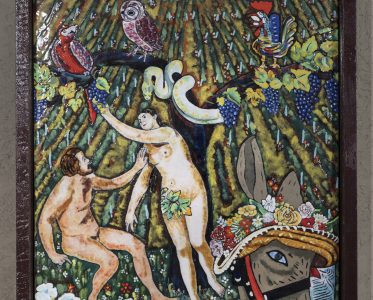
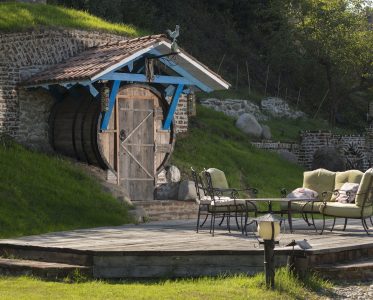
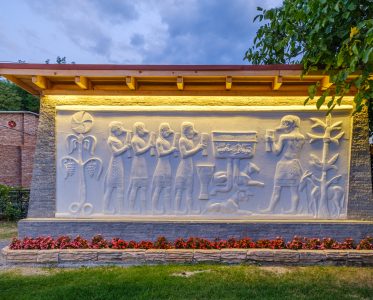
Reviews
It is with pleasure that I think back to the wonderful days of filming at the Shumi winery in Tsinandali. Thanks to the exceptional location of the winery, right in the heart of Georgian viticulture, you gave me a deep insight into the Georgian method of winemaking. The “Qvevri method” is absolutely unique in the world and goes back to an ancient tradition of winemaking. It is not for nothing that Georgia is called the cradle of wine.
You opened up a whole new world to me with your special attitude towards wine. You gladly explained to me all the steps of winemaking according to the “Qvevri method”, carried out by your winemaker Giorgi Khatiashvili. Not least because of this, it has become a beautiful film story.
For this I would like to thank you and all the staff once again. You have certainly made an important contribution to film history that sheds a special light on Georgia. I think my film is a declaration of love to an interesting country with an exceptionally beautiful landscape and its wonderful people.
So beautiful, peaceful and authentic. Brilliant service, and the wine and snacks were delicious. Definitely a must-visit in Georgia.
This peaceful and beautiful winery is absolutely amazing. We visited the wine museum, took a tour and had some wine tastings which were incredible. The whole experience was excellent as the guide was superb and gave us lots of interesting yet relevant information. The wine itself is delicious and full of flavour. The winery offers different private sitting areas that makes the experience really unique.